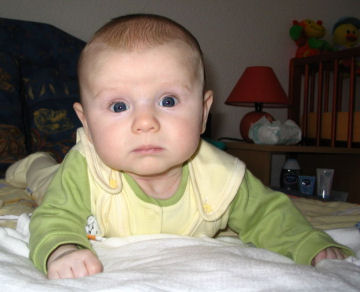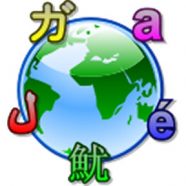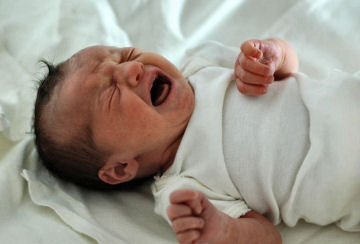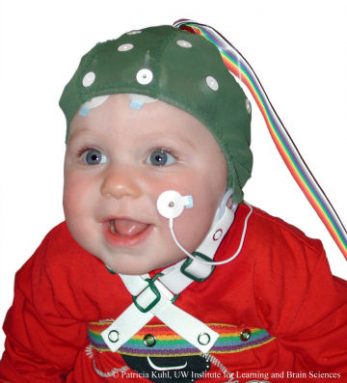Babies prove sound learners
IT can be hard to know what newborns want. They can't talk, walk, or even point at what they're thinking about.
Yet babies begin to develop spoken communication skills long-lived before they begin public speaking, according to recent research. And, compared to adults, they develop these skills quickly. People have a tough time learning new languages as they grow older, simply infants take the ability to learn any language, even off fake ones, well.
For a long meter, scientists have struggled to explain how such young children can learn the complicated grammatical rules and sounds required to communicate in words. Now, researchers are getting a better idea of what's natural event in the brains of society's tiniest language learners.
 |
| Long before they can talk, babies as young as 6 months depart developing language skills. |
| Aleksandra Pospiech/Wikipedia |
The insights power eventually service kids with learning disabilities as well as adults who require to pick up new languages. The work might even assistanc scientists World Health Organization are trying to design computers that backside communicate like the great unwashe do.
"The learning ability of the baby is a inexperienced frontier," says Patricia Kuhl, codirector of the University of Washington's Institute for Learning and Brain Sciences in Seattle. "Today, we babble about what we rear end hear by looking at the very youngest citizens of our culture."
The learning treat
Most babies go "slime goo" and "ma ma," aside 6 months old, and most kids speak in full sentences by geezerhoo 3.
For decades, scientists have debated how the brains of young children chassis out how to transmit using language. With help from raw technologies and research strategies, scientists are now finding that babies begin life with the ability to learn any language. Past interacting with unusual people and using their superb hearing and watching skills, they quickly master the specific languages they discover most oftentimes.
"The [baby] brain is really on the table," says Rebecca Gomez, an experimental psychologist at the University of Arizona, Tucson. Babies "can't say a great deal, but they're learning a lot."
 |
| No peerless knows exactly how many languages are spoken more or less the world, but most estimates put to sleep the number at more than 6,700. |
| Seahen/Wikipedia |
Kuhl's explore, for example, suggests that the patterned advance from babbles like "ga gallium" to actualised words like "in force morning" begins with the power to tell the difference between simple sounds, such as "ga," "atomic number 56," and "da."
Because babies can't tell a man of science what they're hearing, researchers use a different strategy to chink if they can assure sounds apart. In some experiments, for exercise, Kuhl plays recordings of a sound, such arsenic "eeee," over and over to one side of a baby. Then, the researchers beam another sound, such as "aaah," from the infant's other side.
If the baby turns to the late sound, he sees a saltation toy—a reinforce that encourages him to respond to such changes. If he doesn't turn, that suggests that he doesn't hear the dispute 'tween the sounds.
Much studies show that, up to astir 6 months of age, babies can recognize all the sounds that compensate each the languages in the world.
"Their ability to act up that shows that [babies] are prepared to learn any linguistic process," Kuhl says. "That's why we call them 'citizens of the world.'"
 |
| At birth, babies rich person the ability to take heed every sound unwritten in every language around the world—when they're non crying, that is. |
| Inferis/Wikipedia |
About 6,000 sounds cook up the languages spoken around the Earth, simply not every language uses all sound. For example, while the Swedish language distinguishes among 16 vowel sounds, English uses 8 vowel sounds, and Japanese uses just 5. Adults stool hear only the sounds utilised in the languages they speak fluently.
To a native Japanese speaker, e.g., the letters R and L sound identical. So, unlike someone whose native language is European country, a Japanese speaker cannot assure "row" from "low," operating theater "rake" from "lake."
Starting at around 6 months old, Kuhl says, a featherbed's brain focuses on the most common sounds it hears. Then, children begin responding only to the sounds of the lyric they hear the most.
In kind, Gomez has saved, slightly older babies start recognizing the patterns that fabricate the rules of their native language. In English, for example, kids who are about 18 months old start to work that dustup ending in "-ing" surgery "-ed" are usually verbs, and that verbs are action words.
Language along the brain
Scientists are especially concerned in the brains of people World Health Organization speak more than indefinite lyric fluently because that skill is hard to acquire subsequently about age 7.
In matchless of Kuhl's studies, for example, native Mandarin Chinese speakers spoke Chinese to 9-month-old Earth babies for 12 sessions finished 4 weeks. Each academic session lasted about 25 minutes. At the oddment of the study, the American babies responded to Mandarin sounds just also as did Island babies who had been hearing the language their entire lives. (Communicatory teenagers and adults would not perform nearly as well).
To get a better idea of how an infant easily does what an adult ofttimes struggles to make, Kuhl puts a soft lid, titled an electrode cap, on a baby's steer. The cap enables scientists to measure electrical activity in the brain. The amount and position of electrical activity show how much work different parts of the brain are doing.
 |
| This baby is tiring an electrode cap—which painlessly monitors electrical activity in the mentality during experiments. |
| Patricia Kuhl, UW Institute for Learning and Brain Sciences |
The measurements show that the way the brain responds to speech changes dramatically between 6 and 12 months of age. The measurements also show connections forming between parts of the brain that recognize speech and the part that controls the product of speech. If a child on a regular basis hears cardinal languages, her brain forms a different pathway for each lyric.
All the same, erstwhile the Einstein solidifies those electrical lyric pathways by around maturat 7, information technology gets harder to form new ones. By and then, a baby's psyche has disposed of, or pruned, all the unnecessary connections that the infant was born with.
So, if you don't start studying Spanish or Russian until middle school, you must struggle against years of brain development, and progress sack be frustrating. A 12-class-rusty's learning ability has to work a good deal harder to mould language connections than an infant's brain does. Yet in the U.S., learning foreign languages usually begins as late as high school.
"Fighting biology makes [kids] hate French," Kuhl says. "We ought to be [learning new languages] between ages 0 and 7, when the brainpower does it naturally."
Learning from the baby mastermind
Electrode-cap experiments also show that the stronger the response of a 7-month-noncurrent baby's brain to the speech sounds of his autochthonal language, the more words he'll speak by age 3. Measurements like these could help scientists discover early which children are going to have trouble learning to talk. If these kids got redundant attention in their preschool years, they mightiness be less likely to fall behind at one time they move in first grade.
 |
| Distinct languages use different alphabets and different combinations of sounds to create words. Visualized Here is a street check in some Kanarese (an Amerind dialect) and English. |
| Muriel Gottrop/Wikipedia |
Understanding the circuitry of the baby's brain might also help scientists design computers that determine languages As easily as babies do. Useful as computers are, they cannot see a wide range of voices and communicate like people do.
For teenagers and adults who want to find out virgin languages, baby studies may offer some useful tips too. For one thing, researchers have found that it is furthest better for a language learner to talk with people who speak the language than to depend on learning CDs and DVDs with filmed conversations.
When infants watched somebody speaking a established language on TV, Kuhl found, they had a completely antithetical experience than they did if they watched the same speaker in real life. With real speakers, the babies' brains well-lighted improving with electrical activity when they heard the sounds they had learned.
"The babies were looking at the Television set, and they seemed mesmerized," Kuhl says. Learning, all the same, did not happen. "In that respect was nothing going on in their brains," she says. "Dead nothing."
Going Deeper:
Additive Information
Questions about the Clause
Word Find: Goo Goo Ga Tabun

0 Response to "Babies prove sound learners"
Post a Comment